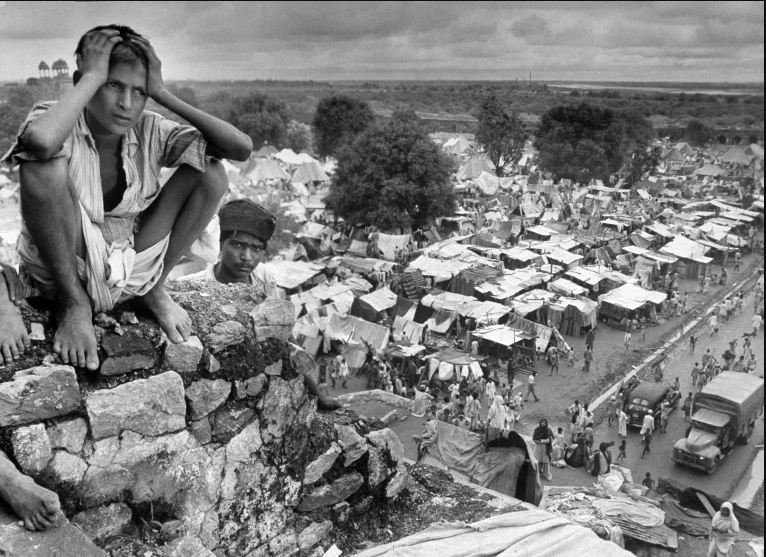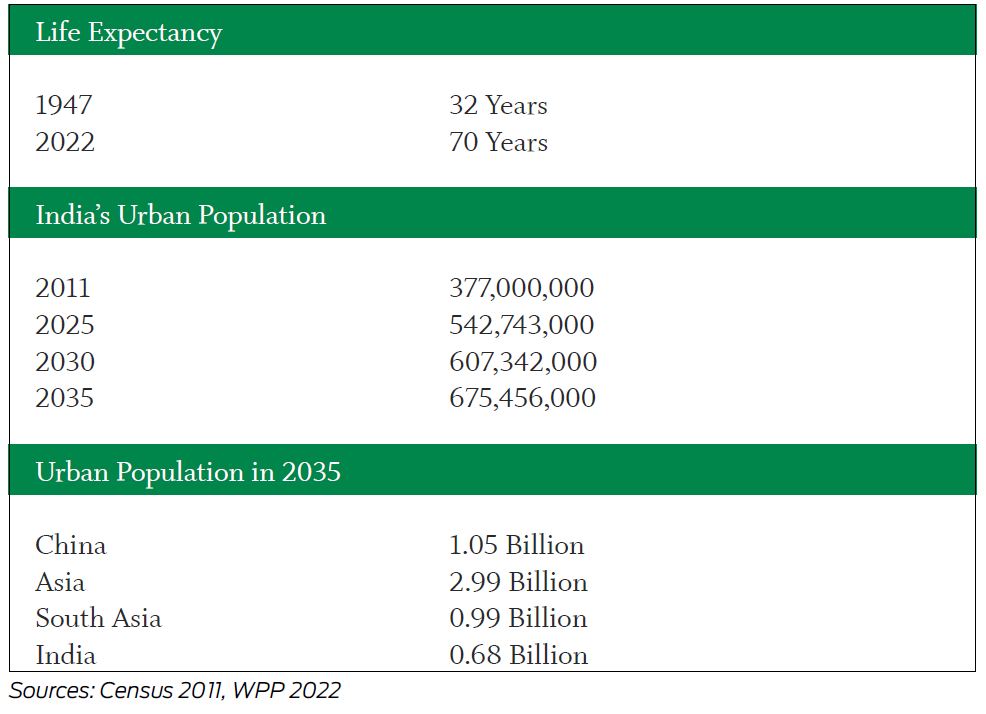India completed 75 years of its Independence this year. It is a special occasion. We need to look back and understand our urban journey to plan a robust urban future by making policies with demographic and climatic considerations. India, a rural country in 1947, has today the second largest urban population after China. The nation needs to reorient its focus on urban issues to make sure urban systems are robust and agile to provide the required support to economic activities and take any challenge head-on, so our journey to become a global economic powerhouse is not blocked

India has come a long way in the 75 years and aspires to reach greater heights when India turns 100 in 2047. In 1947, cities were the centre of focus for good and bad reasons during the period when India got its independence. Delhi, Kolkata, and the towns of Punjab and West Bengal were bleeding as we began our celebration of long-awaited freedom. The reason was: India was divided into two countries. Millions of people migrated from both countries amidst violence.
A photograph taken by Margaret Bourke-White, an American photographer, of Purana Quila in New Delhi tells the story of people’s miseries. A large number of people were living in refugee camps constructed there. They had reached Delhi walking or by trains, leaving their properties and wealth in their native places. They needed a place to stay in the new cities. So, hundreds of thousands of people set up tents wherever they could find a place—in temples, mosques, public places, roadside. The city was filled with migrants who had no place to call home. Historical documents and memoirs of people tell us that the situation was not different in many other Indian cities where migrants moved. Of course, the numbers were different. Delhi being the capital, attracted a majority of migrants.
If we look at the population numbers in the ten most populous Indian cities (as per the 1941 Census), Kolkata was the most populated city with a population of about 3.6 million. Delhi was the fifth most populated city with about 7 lakh population. Mumbai, Chennai and Hyderabad were in second, third and fourth spots, respectively. Another striking fact is that Mumbai’s population (1.75 million) was almost half that of Kolkata. It underlines that Kolkata was a much bigger city those days. Another striking city featured in the top ten was Kanpur at number 7, with more people living here than in Bangalore (now Bengaluru) or Pune. But the journey of Kanpur and Kolkata, colonial towns with British woollen, jute and cotton mills, could not catch up with changing times and lost their shine. Forget about people migrating to these cities; the residents were forced to find employment elsewhere. Every city has written its own story in the last 75 years. Some failed abysmally, and some succeeded and became lighthouses.
The journeys of Mumbai, Bengaluru, and Pune are inspiring, while Kolkata and Kanpur’s stories teach many lessons. That is one aspect of looking at cities. But then, economically successful cities need to improve their performance on many other indicators in the face of new urban challenges. Environmental degradation, loss of biodiversity, traffic congestion, flash floods, and negative impacts of climate change keep reminding us where we went wrong. Cities need to learn, implement optimal solutions, and move forward. In this regard, the role of local leadership and administration is of supreme importance. Many cities in India did not have strong local governments, but after the Balwant Mehta committee report in 1957, state governments took the initiative to constitute municipal corporations and councils in their urban areas. However, many decades later, local governments got constitutional validity in 1992. Despite having limited powers, urban local bodies in India supported urban activities and assisted in the development process of Independent India. Though there are a lot of areas where local governments in cities need improvement, their role in building a new India cannot be ignored.
Importance of city leadership
Managing urban affairs at the local level is critical to supporting industries, businesses, and urban lives to run smoothly. Local governments which failed to provide the services and infrastructure facilities dragged the growth engine to a halt. Local governments are essential, but they are not given due importance when discussing high aspirations for a nation. Often their role is taken for granted.
Our leadership in pre-independent and post-independent India gave importance to the role of local governments. Mahatma Gandhi was a proponent of local governance rule at the village level. Powerful politicians and freedom fighters have decorated the post of mayors in pre- and post-independent India. During the colonial rule, India had some form of local government in a couple of selected cities that included Calcutta (now Kolkata), Bombay (now Mumbai) and Madras (now Chennai), among few others. Freedom Fighter and founder of Indian National Army (INA) Netaji Subhash Chandra Bose was elected as the Mayor of Calcutta in 1930-31. Khursheed Nariman, a senior leader of the Congress Party, remained Mayor of Bombay between 1935-36. Mumbai’s famous Nariman Point is named after him. It shows that local government rule was considered important during those days too.
In Independent India, famous politicians Aruna Asaf Ali (Delhi), Triguna Sen (Kolkata), SK Patil, Manohar Joshi, Chagan Bhujbal, Murali Deora (Mumbai), MK Stalin (Chennai), Devendra Fadnavis (Nagpur), and Sumitra Mahajan (Deputy Mayor, Indore) held mayoral positions. Later, these leaders rose in political ranks and became union ministers, Chief Ministers and even Lok Sabha Speaker. However, in the absence of constitutional validity and limited authority, local governments began losing their prominence. The same is true for the appointment of bureaucrats in Municipal Corporations. Until today, barring a few states, we do not have a municipal cadre in civil services. It puts the city government at a disadvantage because they cannot use the experiences of these officers going ahead. Many municipal commissioners have changed the face of their cities during their tenure. It happens in the life of a city once or twice, and it is not enough.
It is a general perception that politicians and civil servants see their working tenure, even in metropolitan cities, as an inferior career option to serving the state or Union governments. Unlike in many European countries such as France, the United Kingdom, or the United States, no city mayor has yet become Prime Minister or President in India. Even amongst the current members of Lok Sabha and Rajya Sabha, only a handful have honed their political skills at city government. Some of the famous politicians mentioned above rose to political prominence; but these are few, considering the size of India and the number of cities it has. The need for change with further reforms in local governance is being felt.
Urbanisation over the years
The rate of Urbanisation in post-Independent India has not been very high, but it is bound to pick up pace now for various reasons. The number of inhabitants in Indian cities is estimated to have increased almost fourfold between 1970 and 2018, from 109 million to 460 million. Already the second-largest urban community in the world, the country is expected to add another 416 million people to its cities by 2050 and have an urban share of the population of 50 per cent.
Urban India will add over 190 million people in the next 13 years; by 2035. India will need ten cities size of Delhi to accommodate this population, considering Delhi’s population of about 19 million today. The recently released World Population Projections (WPP) says that India will become the most populous country in the world by 2023. It sounds alarming and raises hundreds of questions. What will happen to our already crowded cities?
There is a silver lining. Indian population will stabilise by the middle of the century. However, the urban population will continue to rise because of changes in the nature of the economy. Indian population growth rate has declined significantly from 2.3 in 1972 to less than one in 2022. The Total Fertility Rate (TFR) has also decreased significantly from 5.4 to 2.1.
According to a write-up in the Economic and Political Weekly, the median age of the Indian population has gone up from 20 years in 1950 to 21.6 years in 2000 and 27.9 years in 2022. It will increase to 38.1 years by 2050 and touch 47.5 years by the turn of the century. Indian governments at state and centre need to provide its youth opportunities and functional cities where they can utilize their skills and talent to benefit the nation.
India is better placed than many countries in this regard, but this will not remain the same forever. Indian polity has to use the demographic dividend at its disposal as China did in the 60s.
Glorious future ahead
When India turns 100 in 2047, the country will be an economic powerhouse. It is projected that India will be the third largest economy in the world, a USD 40 trillion economy. Only behind the USA and China. Cities will be the driver in this journey.
India has shown the world in many areas that it can excel. For example, our efficiency in many professional fields has risen to global standards. The management and facilities at our airports are a good example. If someone travelled from Delhi Airport to America or Europe in the 50s, they would praise how foreign countries managed their airports and the kinds of facilities offered to passengers. The table has turned now. People travelling to these countries have praised how Indians manage their airports and customer services. We have seen a complete transformation in this area. Who would have thought that a day would come when airports in India would be better or as good as any airport in developed countries? It is a matter of pride.
When we celebrate Azadi Ka Amrit Mahotsav, our cities only cover about 3 per cent of the country’s area, with 35 per cent of people living in it. If we look at the economic numbers, the urban share of GDP has been on the rise, and the trend is still on the upswing. Today, cities contribute about 55-65 per cent to the national GDP; the percentage varies from various estimations. It is estimated to touch the 85 per cent mark. This change has happened in the last seven decades because more people moved to cities, and the character of the economy changed. In the 1960s, agriculture contributed about 47 per cent to the national GDP, while today, it is just about 13 per cent. India is one of the fastest growing economies in the world, aspiring to become a US$5 trillion economy by 2026 and US$40 trillion by 2047, when India marks 100 years of its independence.
In this journey of prosperity, cities need to support economic activities by providing a strong platform. Urban management and governance need to be top-notch. For this, Urban Local Bodies, state and national governments, civil society, and, more importantly, citizens will have to work together to live this shared dream on India’s centenary of Independence.
During the colonial rule, India had some form of local government in a couple of selected cities that included Calcutta (nowKolkata), Bombay (now Mumbai) and Madras (now Chennai), among few others. Freedom Fighter and founder of Indian National Army (INA) Netaji Subhash Chandra Bose was elected as the Mayor of Calcutta in 1930-31. Khursheed Nariman, a senior leader of the Congress Party, remained Mayor of Bombay between (1935-36). Mumbai’s Nariman Point is named after him. It shows that local government rule was considered important during those days too

